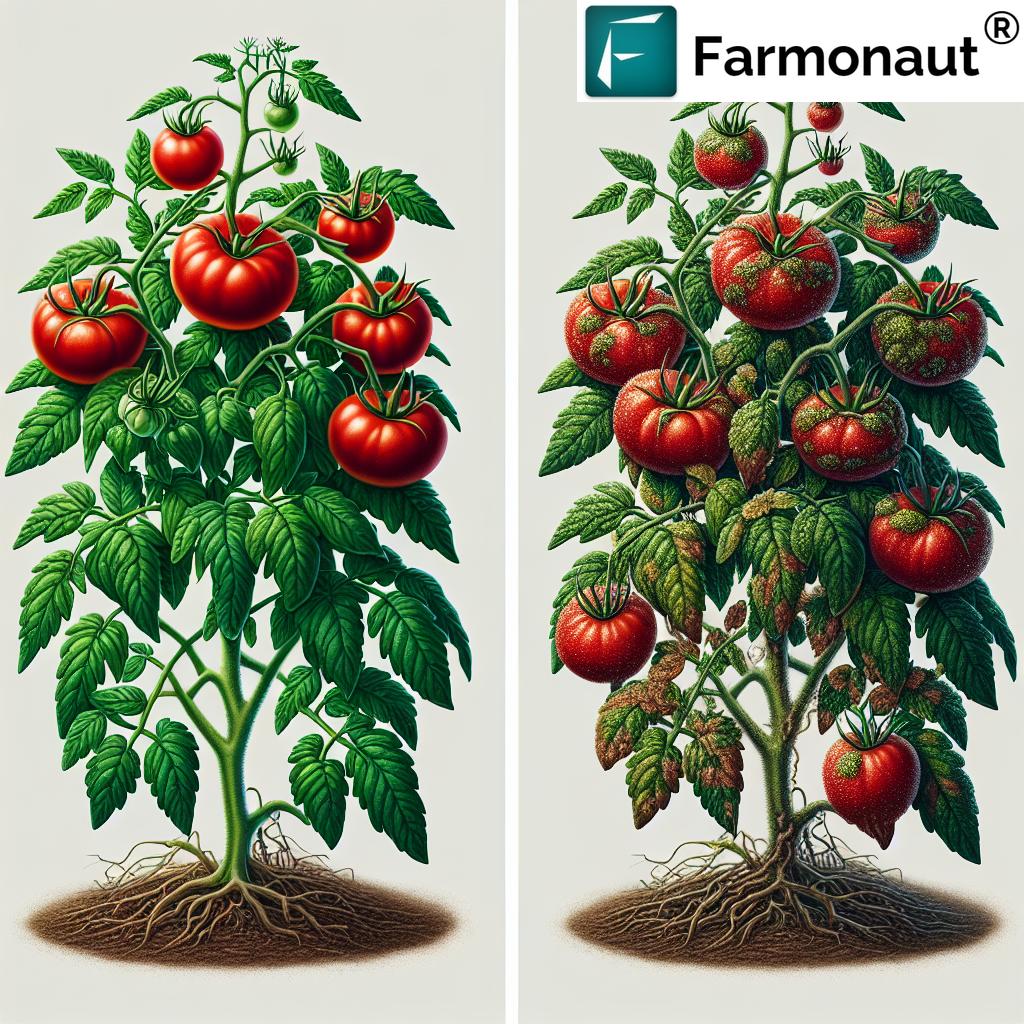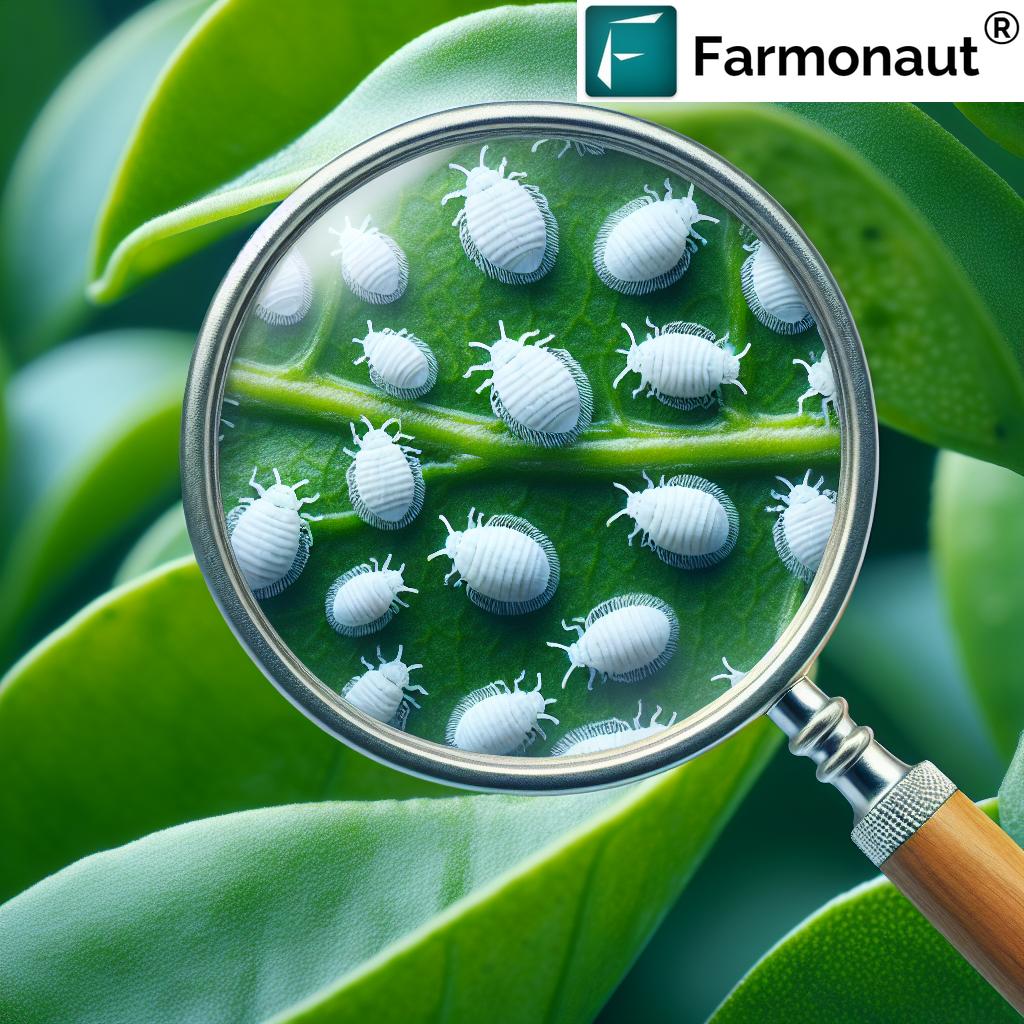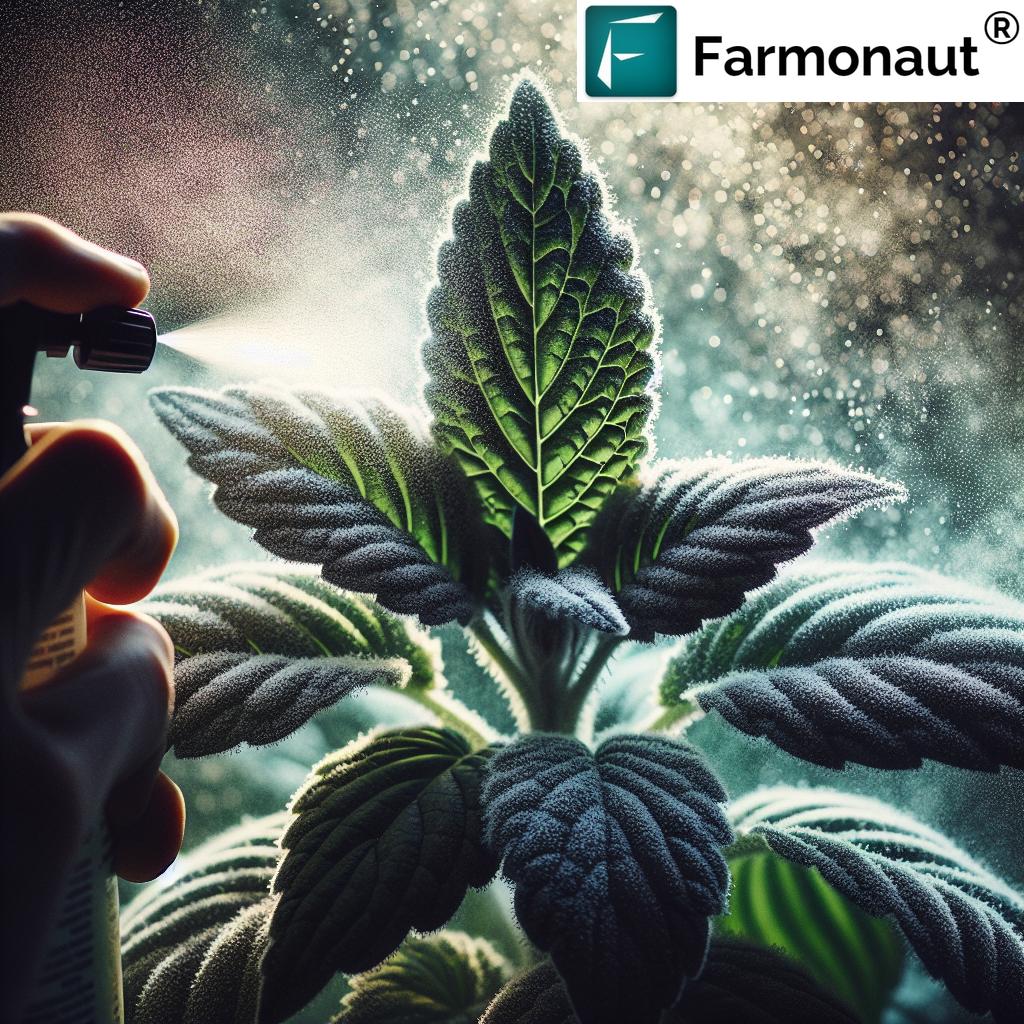Organic Treatment and Control: Managing Tomato Spotted Wilt Virus and Thrips in Diverse Crops

As agricultural experts at Farmonaut, we understand the challenges farmers face when dealing with crop diseases and pests. One of the most troublesome issues in many crops is the Tomato Spotted Wilt Virus (TSWV) and its vector, thrips. In this comprehensive guide, we’ll explore the impact of this virus on various crops, its symptoms, and most importantly, organic and conventional treatment methods to control both the virus and its carrier.
Understanding Tomato Spotted Wilt Virus (TSWV)
Tomato Spotted Wilt Virus is a devastating plant pathogen that affects a wide range of crops worldwide. It belongs to the genus Tospovirus and is primarily transmitted by several species of thrips, tiny insects that feed on plant tissues. The virus can cause significant economic losses in agriculture, affecting both yield and quality of produce.
Crops Affected by TSWV
TSWV has a broad host range, affecting numerous important crops, including:
- Tomato (Tomate in French)
- Pepper
- Potato
- Eggplant
- Lettuce
- Endive
- Celery
- Bean
- Cowpea
- Spinach
- Tobacco
- Peanut
This extensive list highlights the importance of understanding and managing TSWV across various agricultural sectors.
Symptoms of Tomato Spotted Wilt Virus
Recognizing the symptoms of TSWV is crucial for early detection and management. The symptoms can vary depending on the host plant, environmental conditions, and the stage of infection. Here are some common signs to look out for:
General Symptoms Across Crops
- Stunted growth: Infected plants often show reduced growth and vigor.
- Leaf discoloration: Yellowing or bronzing of leaves is common.
- Necrotic spots: Brown or black spots on leaves, stems, and fruits.
- Wilting: Parts of the plant or the entire plant may show signs of wilting (flétrissure in French).
- Ring spots: Concentric rings of discoloration on leaves and fruits.
- Deformed growth: Misshapen leaves, stems, or fruits.
Specific Symptoms in Key Crops
Tomato
- Bronzing of young leaves
- Necrotic spots on leaves, stems, and fruits
- Stunted growth and wilting of terminal shoots
- Uneven ripening of fruits
Pepper
- Chlorotic ring patterns on leaves
- Necrotic streaks on stems
- Distorted fruit growth
Potato
- Yellowing and curling of upper leaves
- Necrotic spots on tubers
- Stunted plant growth
Lettuce
- Chlorotic spots and necrotic areas on leaves
- Stunted growth and reduced head formation

The Role of Thrips in TSWV Transmission
Thrips are small, slender insects that play a crucial role in the spread of TSWV. Understanding their biology and behavior is essential for effective management of the virus.
Thrips Life Cycle
- Egg: Females lay eggs inside plant tissues.
- Larva: Two larval stages feed on plant cells.
- Pupa: Non-feeding stage, usually in soil or plant debris.
- Adult: Winged stage capable of flying and transmitting the virus.
Thrips acquire the virus during their larval stage and can transmit it throughout their adult life. This persistent transmission makes them particularly effective vectors of TSWV.
Factors Influencing Thrips Population and TSWV Spread
- Temperature: Warm conditions favor thrips reproduction and activity.
- Humidity: Moderate humidity levels support thrips survival.
- Host plants: Availability of suitable host plants for feeding and reproduction.
- Wind: Aids in the dispersal of adult thrips.
- Agricultural practices: Monoculture and continuous cropping can increase thrips populations.
Organic Treatment and Control Strategies
At Farmonaut, we advocate for sustainable and organic farming practices. Here are some effective organic methods to manage TSWV and thrips:
1. Cultural Control Methods
- Crop rotation: Rotate susceptible crops with non-host plants to break the disease cycle.
- Weed management: Remove weeds that can serve as alternate hosts for both thrips and the virus.
- Reflective mulches: Use silver or aluminum-colored mulches to repel thrips.
- Trap crops: Plant attractive crops for thrips away from the main crop to lure them away.
- Proper spacing: Ensure adequate plant spacing for good air circulation.
- Sanitation: Remove and destroy infected plant material promptly.
2. Biological Control
Encourage natural predators of thrips, such as:
- Predatory mites (e.g., Amblyseius swirskii)
- Minute pirate bugs (Orius spp.)
- Lacewings
- Predatory thrips (Aeolothrips spp.)
These beneficial insects can help keep thrips populations in check naturally.
3. Organic Insecticides
When necessary, use organic-approved insecticides such as:
- Neem oil: Acts as a repellent and growth regulator for thrips.
- Spinosad: Derived from soil bacteria, effective against thrips.
- Pyrethrin: Natural insecticide extracted from chrysanthemum flowers.
- Insecticidal soaps: Effective against soft-bodied insects like thrips.
Always follow label instructions and rotate insecticides to prevent resistance development.
4. Physical Barriers
- Insect-proof screens: Use in greenhouses and nurseries to prevent thrips entry.
- Row covers: Protect young plants during their most vulnerable stages.
5. Plant Resistance
Choose TSWV-resistant varieties when available. Many breeding programs have developed resistant cultivars for tomatoes, peppers, and other susceptible crops.
Conventional Control Methods
While our focus is on organic methods, we recognize that some situations may require conventional approaches. Here are some conventional strategies for TSWV and thrips control:
1. Chemical Insecticides
Various synthetic insecticides are effective against thrips, including:
- Imidacloprid
- Acephate
- Methiocarb
- Fipronil
Note: Always use insecticides responsibly and in accordance with local regulations. Rotate between different modes of action to prevent resistance development.
2. Systemic Acquired Resistance (SAR) Inducers
Some chemical compounds can trigger the plant’s natural defense mechanisms against viruses. Examples include:
- Acibenzolar-S-methyl
- Harpin proteins
3. Integrated Pest Management (IPM)
Combine various control methods, including cultural, biological, and chemical approaches, for a comprehensive management strategy.
Monitoring and Early Detection
Early detection of TSWV and thrips is crucial for effective management. At Farmonaut, we leverage advanced satellite technology to assist farmers in monitoring crop health and detecting potential issues before they become severe.
Farmonaut Satellite System for TSWV Detection
Our satellite-based crop monitoring system offers several advantages in managing TSWV:
- Early detection: Identify potential infected areas before visible symptoms appear.
- Large-scale monitoring: Cover extensive agricultural areas efficiently.
- Regular updates: Receive frequent data on crop health status.
- Integration with AI: Our Jeevn AI system analyzes satellite data to provide tailored advice on pest and disease management.
To illustrate the effectiveness of our system, here’s a comparison between Farmonaut’s satellite-based detection and traditional scouting methods:
| Feature | Farmonaut Satellite System | Traditional Scouting |
|---|---|---|
| Detection Speed | Can detect anomalies within days of infection | Relies on visible symptoms, which may take weeks to appear |
| Accuracy | High accuracy in detecting stress patterns associated with TSWV | Varies based on scout’s experience and thoroughness |
| Coverage Area | Can monitor hundreds of hectares simultaneously | Limited by time and labor resources |
| Cost-effectiveness | High, especially for large-scale operations | Labor-intensive and costly for large areas |
| Early Intervention | Enables rapid response to potential outbreaks | May miss early stages of infection |
| Data Analysis | AI-powered insights for targeted management | Relies on human interpretation |
By integrating Farmonaut’s satellite monitoring with on-ground observations, farmers can implement a highly effective strategy for managing TSWV and thrips.
Case Studies: Successful Management of TSWV in Different Crops
1. Tomato Production in California
A large-scale organic tomato farm in California implemented an integrated approach to manage TSWV:
- Used Farmonaut’s satellite monitoring to detect early signs of infection
- Implemented reflective mulches and trap crops
- Released predatory mites as biological control
- Applied organic-approved spinosad when necessary
Result: Reduced TSWV incidence by 60% compared to previous years, with a 25% increase in marketable yield.
2. Pepper Cultivation in Spain
A greenhouse pepper producer in Almería, Spain, adopted a comprehensive TSWV management strategy:
- Installed insect-proof screens on all vents
- Used Farmonaut’s AI advisory system for optimal timing of interventions
- Introduced Orius insidiosus as a biological control agent
- Planted TSWV-resistant pepper varieties
Result: TSWV incidence reduced to less than 5% of plants, with a 30% reduction in insecticide use.
3. Lettuce Production in France
An organic lettuce farm in southern France faced recurring TSWV issues:
- Implemented strict weed control measures around fields
- Used Farmonaut’s satellite system to monitor crop health and detect stress patterns
- Applied neem oil as a preventive measure
- Practiced crop rotation with non-host plants
Result: TSWV incidence decreased by 70%, and overall crop quality improved significantly.
Future Perspectives in TSWV Management
As we continue to face challenges in managing TSWV and thrips, several promising areas of research and development are emerging:
1. Advanced Breeding Techniques
Genetic engineering and CRISPR technology are being explored to develop more resistant crop varieties. These techniques could potentially create plants with enhanced natural defenses against TSWV and other viruses.
2. Improved Biological Control Agents
Research is ongoing to identify and develop more effective predators and parasitoids of thrips. This includes exploring new species and enhancing the efficacy of existing biological control agents.
3. Novel Organic Pesticides
Scientists are investigating new plant-based compounds and microorganisms that could serve as effective, environmentally friendly pesticides against thrips and other vectors.
4. Climate-Smart Agriculture
As climate change affects pest and disease patterns, developing climate-resilient farming practices will be crucial. This includes adapting crop management strategies to changing environmental conditions.
5. Precision Agriculture and AI
At Farmonaut, we are continuously refining our satellite monitoring and AI systems to provide even more accurate and timely information on crop health and pest pressures. Future developments may include:
- Integration of ground-based sensors with satellite data for more comprehensive monitoring
- Advanced AI algorithms for predicting TSWV outbreaks based on environmental factors and historical data
- Automated, targeted application of control measures using precision agriculture technologies
Conclusion
Managing Tomato Spotted Wilt Virus and its vector, thrips, requires a multifaceted approach combining cultural, biological, and when necessary, chemical control methods. By leveraging advanced technologies like Farmonaut’s satellite monitoring system and implementing integrated pest management strategies, farmers can significantly reduce the impact of TSWV on their crops.
As we continue to face challenges in agriculture, including climate change and evolving pest pressures, staying informed and adaptable is key. We at Farmonaut are committed to providing farmers with the tools and knowledge they need to protect their crops sustainably and efficiently.
For more information on how Farmonaut can help you manage TSWV and other crop health issues, visit our app page or explore our API services for developers.
FAQs
-
Q: Can TSWV be transmitted through seeds?
A: No, TSWV is not known to be transmitted through seeds. It is primarily spread by thrips feeding on infected plants and then moving to healthy plants. -
Q: How long can thrips survive without a host plant?
A: Adult thrips can survive for several days to a few weeks without a host plant, depending on environmental conditions. However, they require plant material to reproduce and complete their life cycle. -
Q: Are there any natural plant extracts effective against thrips?
A: Yes, several plant extracts have shown effectiveness against thrips, including neem oil, garlic extract, and essential oils from rosemary and thyme. These can be used as part of an organic pest management strategy. -
Q: How often should I monitor my crops for TSWV symptoms?
A: Regular monitoring is crucial. We recommend weekly inspections during the growing season, with more frequent checks during periods of high thrips activity or when environmental conditions favor virus spread. -
Q: Can TSWV-infected plants recover?
A: Unfortunately, plants infected with TSWV do not recover. The best approach is prevention and early detection to minimize spread to healthy plants. -
Q: How does Farmonaut’s satellite system detect TSWV?
A: Our satellite system uses multispectral imaging to detect changes in plant health and vigor. While it cannot directly detect the virus, it can identify stress patterns and anomalies associated with TSWV infection, often before visible symptoms appear. -
Q: Are there any beneficial effects of thrips in agriculture?
A: While thrips are primarily known as pests, some species can be beneficial as pollinators or predators of other pests. However, in the context of TSWV management, their negative impact far outweighs any potential benefits. -
Q: How can I integrate Farmonaut’s technology into my existing farm management practices?
A: Farmonaut offers flexible solutions that can be easily integrated into various farm management systems. You can start by downloading our mobile app (Android | iOS) or exploring our API documentation for custom integrations.
For more detailed information on our API services, please refer to our developer documentation.
Subscribe to Farmonaut Services
Ready to take your crop management to the next level? Subscribe to Farmonaut’s advanced satellite monitoring and AI advisory services:
By subscribing, you’ll gain access to cutting-edge technology that can help you detect and manage TSWV and other crop health issues more effectively, leading to improved yields and sustainable farming practices.










